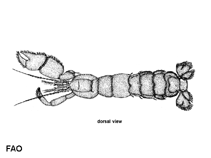Callichirus kraussi (Stebbing, 1900)
Pink ghost shrimp
Classification / Names Common names | Synonyms | CoL | ITIS | WoRMS
Malacostraca | Decapoda | Callichiridae
Environment: milieu / climate zone / depth range / distribution range Ecology
Benthic; brackish. Subtropical; 25°S - 36°S, 16°E - 35°E (Ref. 4)
Distribution Countries | FAO areas | Ecosystems | Occurrences | Introductions
Southeast Atlantic and Western Indian Ocean: from South Africa to Mozambique.
Length at first maturity / Size / Weight / Age
Maturity: Lm ? range ? - ? cmCommon length : 7.0 cm TL male/unsexed; (Ref. 4)
Short description Morphology
Rostrum broadly triangular, far overeached by the eyes that are oval. Antennal angle low and blunt, without spine. Antennular peduncle much longer than antennal peduncle, which it overreaches with more than half the length of the last segment. Third maxilliped with merus and ischium strongly widened to form a operculum. Carpus somewhat widened, being less than twice as long as wide; propodus strongly widened, being wider than long; dactylus slender. Large chela of adult male with a deep, but rather wide concavity in the anterior margin of the palm above the fixed finger. Carpus about as long as pal, and as long as high. Merus with a rounded lobe in basal part of lower margin. Surface of larger cheliped with numerous tubercles. Telson distinctly wider than long and much shorter than uropods, being only somewhat more than half as long as endopod. Lateral margins of telson convex, posterolateral corners rounded, posterior margin almost straight, without a spine. Endopod of uropod elongate oval (Ref. 4).
It has a total body length of 7 cm (Ref. 4).
Life cycle and mating behavior Maturity | Reproduction | Spawning | Eggs | Fecundity | Larvae
Members of the order Decapoda are mostly gonochoric. Mating behavior: Precopulatory courtship ritual is common (through olfactory and tactile cues); usually indirect sperm transfer.
Main reference
References | Coordinator | Collaborators
Holthuis, L.B. 1991. (Ref. 4)
IUCN Red List Status (Ref. 130435: Version 2024-1)
CITES status (Ref. 108899)
Not Evaluated
CMS (Ref. 116361)
Not Evaluated
Threat to humans
Human uses
Bait: usually
| FishSource |
Tools
More information
Trophic Ecology
Food items
Diet
Food consumption
Ration
Predators
Diet
Food consumption
Ration
Predators
Ecology
Population dynamics
Growth
Age/Size
Length-weight
Length-length
Length-frequencies
Mass conversion
Recruitment
Abundance
Age/Size
Length-weight
Length-length
Length-frequencies
Mass conversion
Recruitment
Abundance
Life cycle
Distribution
Human Related
Aquaculture profile
Stamps, Coins Misc.
Stamps, Coins Misc.
Outreach
References
Internet sources
BHL | BOLD Systems | CISTI | DiscoverLife | FAO(Publication : search) | Fishipedia | GenBank (genome, nucleotide) | GloBI | Gomexsi | Google Books | Google Scholar | Google | PubMed | Tree of Life | Wikipedia (Go, Search) | Zoological Record



